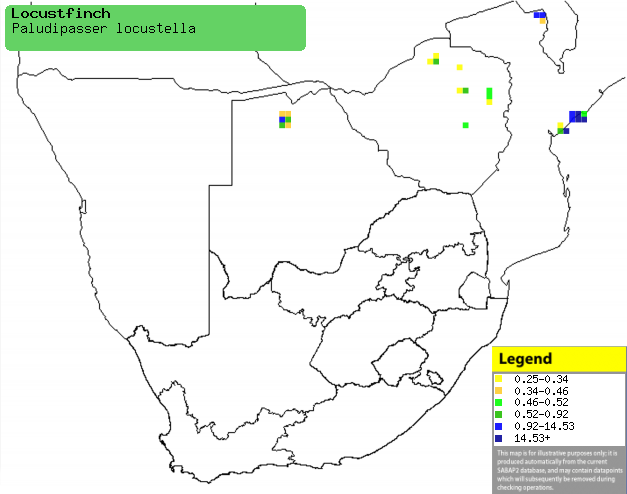|
Paludipasser locustella
(Locustfinch)
[= Ortygospiza locustella]
Rooivlerkkwartelvinkie [Afrikaans]; Sprinkhaanastrild
[Dutch]; Astrild-caille à gorge rouge [French]; Heuschreckenastrild
[German]; Bico-de-lacre-gafanhoto [Portuguese]
Life
> Eukaryotes >
Opisthokonta
> Metazoa (animals) >
Bilateria >
Deuterostomia > Chordata >
Craniata > Vertebrata (vertebrates) > Gnathostomata (jawed
vertebrates) > Teleostomi (teleost fish) > Osteichthyes (bony fish) > Class:
Sarcopterygii (lobe-finned
fish) > Stegocephalia (terrestrial
vertebrates) > Tetrapoda
(four-legged vertebrates) > Reptiliomorpha > Amniota >
Reptilia (reptiles) >
Romeriida > Diapsida > Archosauromorpha > Archosauria >
Dinosauria
(dinosaurs) > Saurischia > Theropoda (bipedal predatory dinosaurs) >
Coelurosauria > Maniraptora >Aves
(birds) > Order: Passeriformes
> Family: Estrildidae
Distribution and habitat
Occurs in two separate areas of sub-Saharan Africa, one in
western DRC and Congo and the other extending from eastern Zambia to southern
Tanzania, Malawi, northern Mozambique and southern Africa. Here it is generally
uncommon, occupying small patches of northern Botswana, north-eastern Zimbabwe
and central Mozambique. It generally prefers marshy areas and adjacent moist,
short grassland, with patches of bare waterlogged ground between grass tufts.
|
 |
|
Distribution of Locustfinch in southern Africa,
based on statistical smoothing of the records from first SA Bird Atlas
Project (©
Animal Demography unit, University of
Cape Town; smoothing by Birgit Erni and Francesca Little). Colours range
from dark blue (most common) through to yellow (least common). |
Predators and parasites
It has been recorded as prey of
Falco chicquera
(Red-necked falcon).
Movements and migrations
Nomadic in the dry season, travelling great
distances in search of moist habitats.
Food
It mainly eats grass seeds, doing most of its foraging on
the ground between grass tufts.
Breeding
- The nest is a ball of grass with a side entrance, made of fine grass
blades and lined with feathers, typically placed just above ground in a
grass tuft in a marsh or vlei.
- Egg-laying season is from January-May, peaking from January-February.
- It lays 4-8 eggs, which are incubated mainly by the female.
- Little is known about the chicks, other then that they are fed by both
parents.
Threats
Not threatened.
References
-
Hockey PAR, Dean WRJ and Ryan PG 2005. Roberts
- Birds of southern Africa, VIIth ed. The Trustees of the John Voelcker
Bird Book Fund, Cape Town.
|
